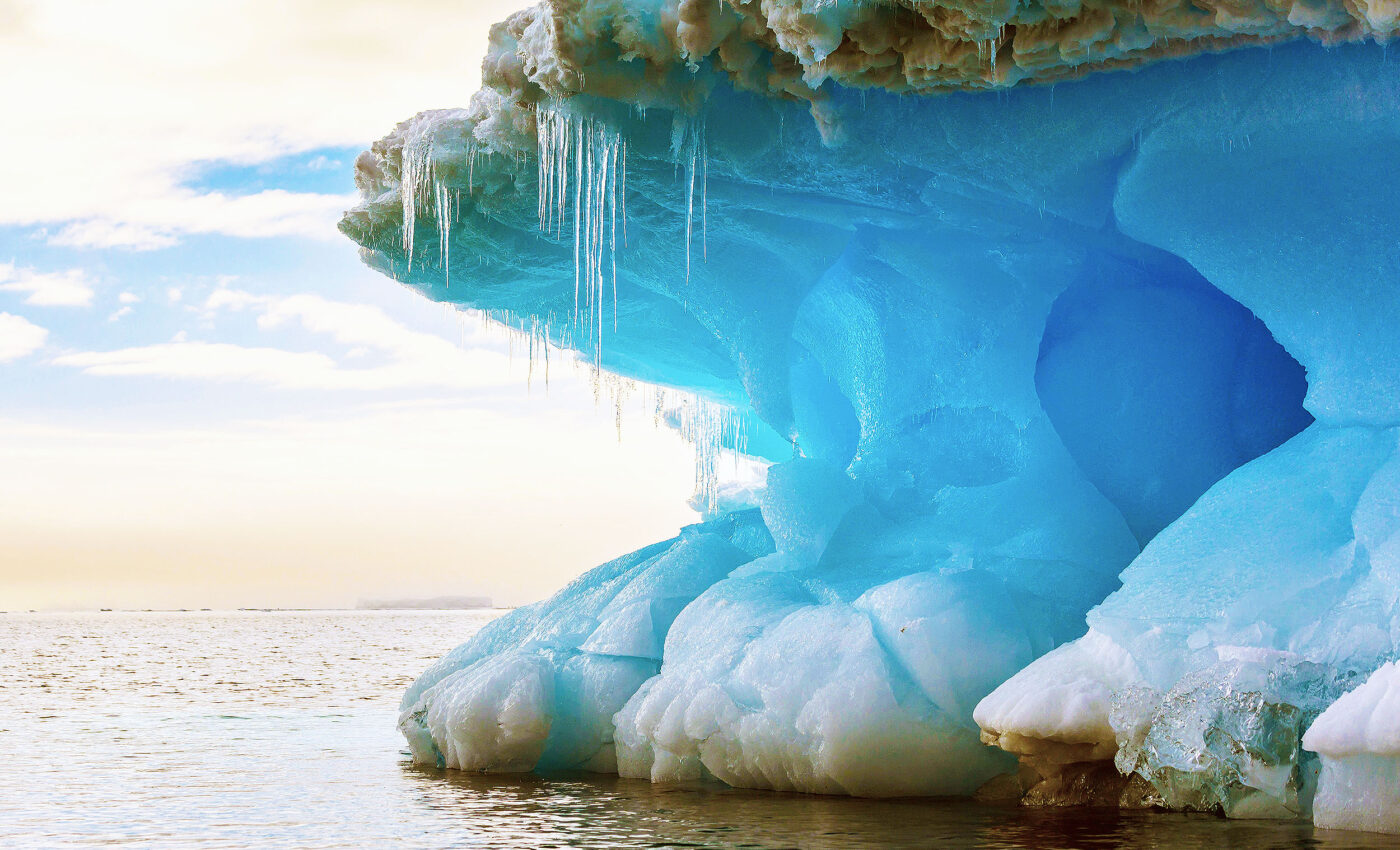
World’s largest iceberg, A23a, is adrift and seeing major erosion and melting
The world’s largest iceberg, A23a, is undergoing significant erosion and transformation as it moves away from Antarctica. Captured in new photos and videos, the iceberg, measuring 1,540 square miles, is being reshaped by ocean waters, forming caves and arches.
The erosive process, similar to coastal land erosion, is accelerated by waves crashing against the iceberg, gradually enlarging gaps until the top layers collapse.
Mind-boggling size
EYOS Expeditions, who recently visited iceberg A23a, deployed a drone for aerial photography. Expedition leader Ian Strachan described the scene, thusly.
“We saw waves, a good three meters or four meters high, smashing into the berg… These were creating cascades of ice – a constant state of erosion.”
“It’s mind-bogglingly big and stretches as far as you can see in both directions… It’s certainly too big to photograph,” added videographer Richard Sidey.
The erosion process involves powerful waves hitting the iceberg’s base, creating small gaps that eventually widen into caves and arches, leading to the collapse of the ‘roof’ or the top ice layer. This leaves behind smaller stacks that eventually melt away.
Potential impact of iceberg A23a
A23a, grounded to the ocean floor for 30 years, is now drifting northwards due to wind and ocean currents.
The British Antarctic Survey (BAS) revealed that the iceberg is moving at about 30 miles per day and may enter “iceberg alley” towards South Georgia.
According to a BAS spokesperson, “it depends on its trajectory, but there is potential for impact to wildlife if it approaches any of the sub-Antarctic islands.”
Originally part of the Filchner Ice Shelf, A23a became stationary after grounding, a phenomenon that occurs when an iceberg’s keel is deeper than the water’s depth.
Scientists noted its movement in November, with the iceberg now on a northward journey.
The title of world’s largest iceberg
Despite its current title as the world’s largest iceberg, this status is temporary, as icebergs inevitably fragment.
The previous largest iceberg, A76, detached from the Weddell Sea ice shelf in May 2021 but has since broken into three pieces.
One of the most notable was Iceberg A-68, which calved from the Larsen C Ice Shelf in Antarctica in July 2017.
At the time of its calving, A-68 was one of the largest ever recorded, measuring about 5,800 square kilometers (2,240 square miles) in area, roughly the size of Delaware or the island of Trinidad.
Over time, these massive icebergs break into smaller pieces and eventually melt. Satellite imagery and tracking have been crucial in monitoring their movements and changes, providing valuable data for understanding the dynamics of polar regions in the context of climate change.
More about iceberg A23a
In the vast, frigid waters of the Southern Ocean, Iceberg A23a stands as a monumental testament to nature’s grandeur and the dynamic processes shaping our planet.
As discussed above, this massive iceberg, once part of Antarctica’s sprawling ice shelf, embarked on an extraordinary journey that captures the attention of scientists and the public alike.
Origins and discovery
Iceberg A23a broke away from the Filchner-Ronne Ice Shelf, a significant section of the Antarctic ice sheet. Its calving, a natural part of the ice shelf’s life cycle, was a spectacle of nature’s power.
The moment it separated, A23a became an independent entity, charting a course through the world’s southernmost waters.
Iceberg A23a size and structure
Measuring over a hundred kilometers in length and breadth, A23a is comparable in size to major global cities, dwarfing most other icebergs.
Its towering walls of ice rise majestically, while the bulk of its mass, like that of all icebergs, remains hidden underwater.
This colossal size makes A23a a subject of fascination and a vital piece in understanding the Earth’s cryosphere.
Impact on the environment
As A23a drifts, it influences the oceanic currents and the marine ecosystem. The iceberg’s immense size acts as a floating barrier, redirecting water flows and potentially altering weather patterns.
Moreover, its gradual melting process releases vast amounts of freshwater, impacting the salinity of the surrounding ocean, which can have far-reaching effects on marine life.
Scientific significance
The journey of A23a provides a unique opportunity for research. Scientists employ satellites, drones, and ship-based observations to track its movement and study its impact.
This research offers insights into the behavior of icebergs and the broader implications for global climate patterns. The data gathered helps refine models predicting the response of polar regions to climate change.
Iceberg A23a and climate change
The story of A23a is intrinsically linked to the narrative of global warming. The increasing rate of iceberg calving in Antarctica raises concerns about the stability of ice shelves and the potential for accelerated sea-level rise.
A23a’s voyage is a vivid, tangible example of these changes. While its contribution to sea-level rise is minimal compared to glacial meltwater, it symbolizes the larger, more pressing issue of our warming planet.
Cultural and social impact of iceberg A23a
Beyond its scientific importance, A23a has captured the public’s imagination. It represents the remote and wild beauty of the Antarctic region and serves as a powerful symbol of the natural world’s scale and mystery.
In a world increasingly concerned with environmental issues, A23a’s journey is a reminder of the need for stewardship and understanding of our planet’s delicate ecosystems.
Symbol of change and discovery
As Iceberg A23a continues its solitary voyage, it remains a subject of awe and study. It stands as a stark reminder of the Earth’s changing climate and the urgent need to understand and protect our planet’s polar regions.
In summary, the story of A23a is not just about a massive chunk of ice. The takeaway here is the interconnectedness of our global environment and the shared responsibility we hold in safeguarding it for future generations.
Like what you read? Subscribe to our newsletter for engaging articles, exclusive content, and the latest updates.
—-
Check us out on EarthSnap, a free app brought to you by Eric Ralls and Earth.com.













